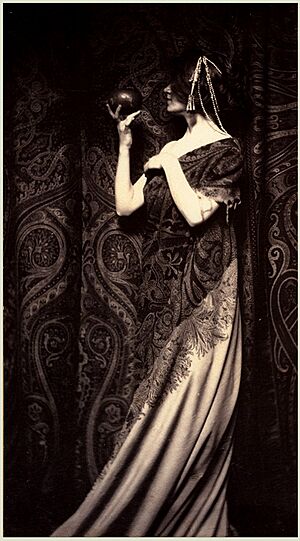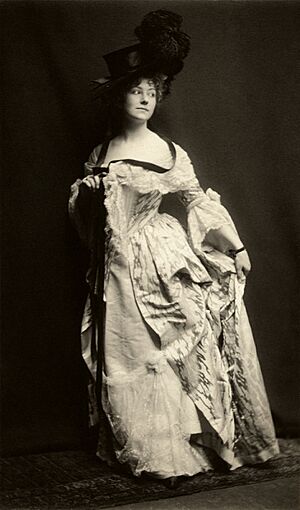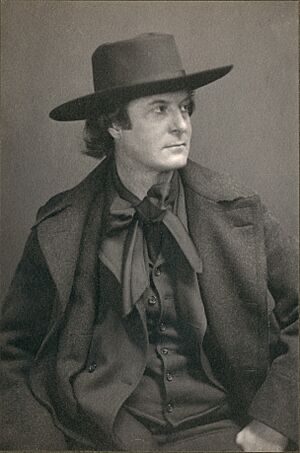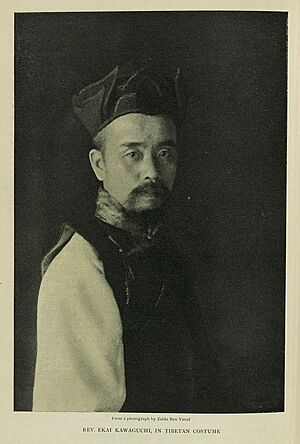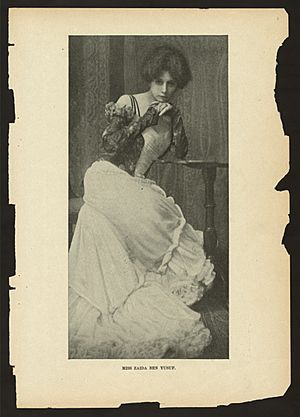Zaida Ben-Yusuf facts for kids
Quick facts for kids
Zaida Ben-Yusuf
|
|
|---|---|
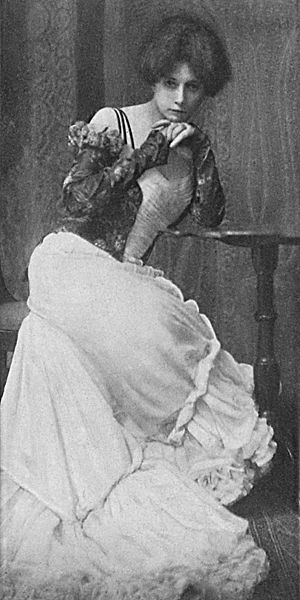
Self portrait, 1901
|
|
| Born |
Esther Zeghdda Ben Youseph Nathan
21 November 1869 London, England
|
| Died | 27 September 1933 (aged 63) Brooklyn, New York
|
| Known for | Photography |
Zaida Ben-Yusuf (born November 21, 1869 – died September 27, 1933) was a talented photographer. She was born in England but lived in New York. Zaida was famous for taking artistic pictures of rich, stylish, and well-known Americans. She worked around the late 1800s and early 1900s.
In 1901, a magazine called The Ladies Home Journal named her one of the "Foremost Women Photographers in America." Later, in 2008, the Smithsonian National Portrait Gallery held a special show just for her photos. This helped people remember her important role in the early days of fine art photography.
Contents
Zaida Ben-Yusuf's Life Story
Early Years and Family
Zaida Ben-Yusuf was born as Esther Zeghdda Ben Youseph Nathan. She was born in London, England, on November 21, 1869. She was the oldest daughter of Anna Kind Ben-Youseph Nathan, who was German, and Mustapha Moussa Ben Youseph Nathan, who was Algerian.
By 1881, her mother lived in Ramsgate with her four daughters. Anna worked as a governess, teaching children in their home. She had separated from Zaida's father.
In 1888, Anna Ben-Yusuf moved to Boston, Massachusetts, in the United States. By 1891, she had opened a shop that made and sold hats, called a milliner's shop.
In 1895, Zaida followed her mother and moved to the United States. She also worked as a milliner in New York City. Even after she became a photographer, she sometimes wrote articles about making hats for magazines like Harpers Bazaar.
Photography Career Begins
Zaida Ben-Yusuf started to become known as a photographer in 1896. Two of her pictures were shown in The Cosmopolitan Magazine. Another photo was displayed in London at an exhibition by a group called The Linked Ring.
She traveled to Europe later that year. There, she met George Davison, who helped start The Linked Ring. He encouraged her to keep taking photos. She showed her work at their yearly exhibitions until 1902.
In the spring of 1897, Zaida opened her own photography studio in New York City. Newspapers like the New York Daily Tribune wrote about her studio and her work. She became very popular in 1898.
Ten of her photos were shown at a big fair in New York. Her picture of actress Virginia Earle won third place. In November 1898, Zaida and another photographer, Frances Benjamin Johnston, had a special show together.
In 1899, Zaida moved her studio to a new location. She showed her photos in several exhibitions. She was also featured in many magazines. One writer, Sadakichi Hartmann, called her an "interesting exponent of portrait photography."
In 1900, Zaida helped organize an exhibition of American women photographers in Paris. Her five portraits were part of this show, which later traveled to other cities. Her photos were also chosen for other important exhibitions in London and Glasgow, Scotland.
In 1901, Zaida wrote an article for Saturday Evening Post called "Celebrities Under the Camera." She wrote about her experiences photographing famous people. She had taken pictures of Grover Cleveland, Franklin Roosevelt, and Leonard Wood.
She also wrote about her artistic photography style. The Ladies Home Journal named her one of the "foremost women photographers in America." She then wrote a series of articles for amateur photographers.
Zaida was part of the first American Photographic Salon in 1904. However, she started showing her work less often. Her last known exhibition was in 1906.
Travels and Later Work
In 1903, Zaida traveled to Japan. She visited many cities like Yokohama, Kobe, and Kyoto. This trip led to a series of articles she wrote for the Saturday Evening Post called "Japan Through My Camera."
She also wrote about Japanese architecture and gave talks about it. Some of her photos were used to illustrate articles by other writers.
In 1906, she published photos from a trip to Capri. In 1908, she wrote essays about life in England. She returned to New York in November 1908 but was back in London the next year. By 1912, it was said that Zaida had stopped photography.
When World War I started in 1914, Zaida returned to New York from Paris. In 1919, she applied to become an American citizen. She still traveled, visiting Cuba in 1920 and Jamaica in 1921.
Later Life and Legacy
In 1924, Zaida Ben-Yusuf started working for Reed Fashion Service in New York City. She gave talks about fashion at department stores. In 1926, she became the style director for the Retail Millinery Association of New York. She later became the director of the organization.
By 1930, records show that Zaida had married Frederick J. Norris, a textile designer. She passed away three years later, on September 27, 1933, in a hospital in Brooklyn.
Her Work at the National Portrait Gallery
Zaida Ben-Yusuf's work was featured in a special exhibition. It was called Zaida Ben-Yusuf: New York Portrait Photographer. The show was at the Smithsonian's National Portrait Gallery from April 11 to September 1, 2008.
The person who organized the show, Frank H. Goodyear III, found two of her photos in 2003. He wanted to learn more about this photographer who had been mostly forgotten.
Goodyear thought that gender discrimination might have caused Zaida to be forgotten. Photography history often focused on male photographers like Alfred Stieglitz. Female photographers were less remembered, even though photography was a good career for single women back then. It was hard for a single professional woman to support herself in New York.
Another reason Zaida was forgotten was that she didn't leave a large collection of her work to one place. This made it hard for historians to study her career. The exhibition at the Smithsonian helped bring Zaida Ben-Yusuf back into the spotlight. It showed her as a very important person in the history of fine art photography.
See also
 In Spanish: Zaida Ben-Yusuf para niños
In Spanish: Zaida Ben-Yusuf para niños


